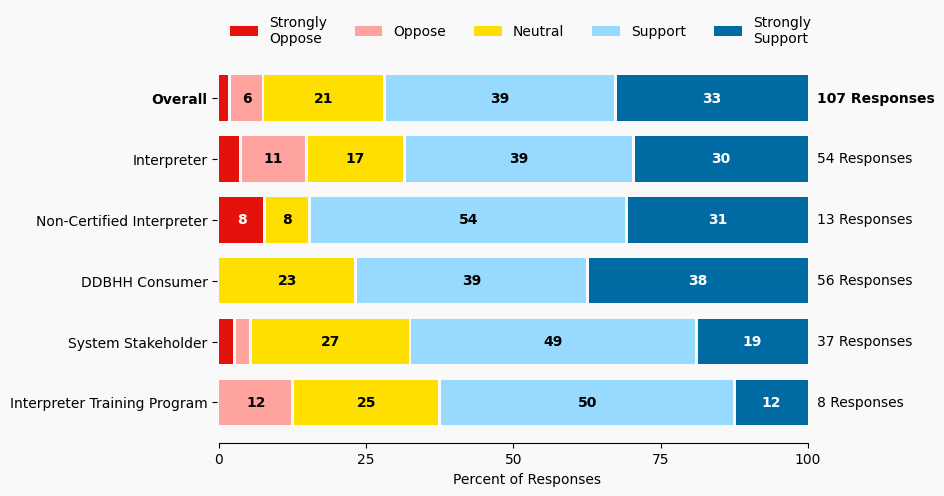103 Encourage Community Input on Interpreter Training Program Curricula
Issue: Consumers and ITPs do not generally have regular communication about ITP curriculum.
Proposed Solution: ITPs host forums for consumers and students to share their program, curriculum, modules covered and opportunities for consumers and community members to be engaged in program activities to support students’ growth.
Expected outcome: With this information sharing about what is being taught, consumers and students can offer input to ITPs’ curricula during the scheduled forum times.
Who is impacted: Interpreting students, ITPs, consumers
Timeline: 6 months
Note: Several suggestions were made for skills and approaches that ITPs could incorporate. Information sharing with the community is a preliminary step where community members can learn what curricula is offered, and then to offer input.

Summary of Support Image Description
The stacked bar charts show how respondents rated their level of support and the total number of responses. The percentage for the five support levels is shown from left to right: Strongly Oppose (Dark Red), Oppose (Light Red), Neutral (Yellow), Support (Light Blue), and Strongly Support (Dark Blue).
Respondents may identify with multiple subgroups. The overall level of support is:
Overall
Strongly Oppose: 2%
Oppose: 6%
Neutral: 21%
Support: 39%
Strongly Support: 33%
Click to see the detailed image description for each subgroup.
Interpreter
Strongly Oppose: 4%
Oppose: 11%
Neutral: 17%
Support: 39%
Strongly Support: 30%
Non-Certified Interpreter
Strongly Oppose: 8%
Oppose: 0%
Neutral: 8%
Support: 54%
Strongly Support: 31%
DDBHH Consumer
Strongly Oppose: 0%
Oppose: 0%
Neutral: 23%
Support: 39%
Strongly Support: 38%
Interpreter Training Program
Strongly Oppose: 0%
Oppose: 12%
Neutral: 25%
Support: 50%
Strongly Support: 12%
System Stakeholder
Strongly Oppose: 3%
Oppose: 3%
Neutral: 27%
Support: 49%
Strongly Support: 19%
Overview of Respondents Opting for In-Depth Solution Analysis
After indicating their support level, 3% of the 107 respondents opted in to further assess whether the solution would worsen or improve on five metrics. Of the opt-in reviewers (4 respondents), 50% supported the solution, 25% were neutral on the solution, and 25% opposed the solution.
The remaining 103 respondents did not opt in to further assess the solution. Of these people, 72% support the solution, 20% were neutral on the solution, and 6% opposed the solution.
Reviewer Evaluation of Solution Effectiveness

Solution Effectiveness Image Description
The stacked bar charts show how respondents assessed the effectiveness of this solution based on five metrics. For each metric, the percentage of respondents is shown from left to right: Worsens (Red), Improves (Blue), No Impact (Gray).
DDBHH Quality of Life
Makes It Worse 0%
Makes It Better 80%
No Impact 20%
Interpreter Satisfaction
Makes It Worse 0%
Makes It Better 83%
No Impact 16%
Consumer Choice
Makes It Worse 0%
Makes It Better 83%
No Impact 16%
Interpreting Availability
Makes It Worse 0%
Makes It Better 80%
No Impact 20%
Interpreting Quality
Makes It Worse 0%
Makes It Better 100%
No Impact 0%
Reviewer Feedback and Insights
Interpreter
Comments from Interpreters note that advisory groups already exist at institutions like St. Kate’s and St. Paul College and emphasizes the importance of growing community collaboration. Another comment supports the idea but warns that community feedback could overwhelm ITPs with requests, suggesting open discussions that account for ITP limitations. One comment highlights the outdated materials used in ITPs and stresses the need for consumer input to ensure graduates have the necessary knowledge and confidence.
Deaf, DeafBlind, Hard of Hearing
No comments were submitted.
System Stakeholder
Comments from System stakeholders note the existence of advisory groups at ITPs and questions how this proposed solution differs from current practices. Another comment suggests that involving more community members could help raise awareness about what interpreting programs do and how the community can support them.
PREVIOUS SOLUTION
102 Emphasize Direct Community Experience as Part of ITPs
Issue: Many new interpreters appear to have a disconnect from the DDBHH community experience, according to some DDBHH people and seasoned interpreters’ perspectives. Consumers report interpreters’ skills are not as strong, and the understanding and empathy, which are important aspects for successful communication and interpretation, are missing due to the lack of connection with DDBHH people’s experiences.
NEXT SOLUTION
Issue: Disproportionate representation of white interpreters to a more racially diverse DDBHH community members. BIPOC DDBHH community members rarely receive culturally appropriate interpreters.
Leave a Reply